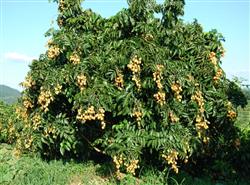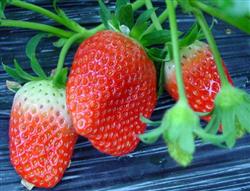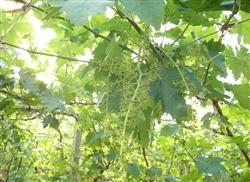How to cultivate seedless yellow fruit?

How to cultivate seedless yellow fruit? How to manage seedless yellow fruit? Experienced netizens are also asked to help introduce that Seedless wampee is a better variety selected from the seedless wampee varieties introduced by the Horticultural Research Institute of Guangxi Academy of Agricultural Sciences from inside and outside the region, with a high seedless rate (generally more than 95%) and high nutrients (18% of soluble solids in seedless yellow fruit). 5%, total acid 0. 35%, moderate ratio of sugar to acid), high yield (more than 8.5 kg per plant in the fourth year after planting) and so on. Therefore, the planting network has sorted out the planting techniques and management methods of seedless yellow fruit, which are listed in detail below for netizens' reference. First, the choice of seedless yellow fruit planting site: seedless yellow fruit should choose good drainage and irrigation, loose, fertile, moist loam, sandy loam and gravelly soil. Do not plant land stagnant water, soil sticky heavy plate planting. 2. Planting time and density of seedless yellow fruit: seedless yellow skin is generally planted in spring (March-May). The planting density can be 2.5 m × 3 m or 3 m × 4 m with 88 or 55 plants per mu. In order to bear fruit early and harvest early, it is appropriate to use excellent grafted seedlings. Do not plant too deep (the same depth as the mu in the nursery), compact the soil, raise the pier, trim the tree plate (20-30cm above the ground), and cover the grass with water. Special attention should be paid to: only when the young trees grow new buds and leaves mature (about 40 days after planting) can thin fertilizer be applied. 3. Fertilization of seedless yellow fruit: 1. Young tree stage: annual fertilization should be thin and diligent, mainly nitrogen, combined with phosphorus, potassium and magnesium. Fertilizer was applied once before each shoot and in the period of turning green, that is, the method of "one shoot and two fertilizers" was used to promote and strengthen new shoots. 2. Fruiting tree period: fertilization is usually applied three times a year. The first flower-promoting fertilizer before and after Greater Cold, the combination of late effect and quick effect, the ratio of nitrogen, phosphorus and potassium was 1.0, 0.5 and 0.8, and the amount of fertilizer application accounted for about 25% of the whole year. For the second time, strong fruit promotes summer shoot fertilizer, which is mainly potassium and nitrogen before fruit thinning, and the amount of fertilizer application accounts for about 30% of the whole year. For the third time, the amount of fertilizer applied to promote autumn shoot after fruit harvest accounted for about 45% of the whole year. Fourth, the watering of seedless yellow fruit: the root system of seedless yellow bark tree is shallow and good-natured; it is not resistant to drought and avoid poor ventilation, and the garden is flooded. Therefore, seedless yellow orchards should not only pay attention to drainage in rainy season, prevent stagnant water in planting land, but also moisturize and irrigate during drought. Attention should be paid to irrigation and drought resistance during autumn shoot germination after fruit harvest. 5. Pruning of seedless yellow fruit trees: after the seedless yellow fruit trees were planted and survived, the trunk was cut short at 40 cm to 50 cm above the ground, and 3 branches with similar size and uniform distribution were selected as the main branches; when the main branches were ripe, 30 cm coring or short cutting was left to promote the germination of new shoots, and 3 branches were selected as secondary branches. When it is mature, leave 20-30cm coring, cut short, promote and select 3 new shoots as third-grade branches, and cultivate the next-level shoots by the same method. In the pruning of the fruit tree, in addition to cutting off withered branches, disease and insect branches, shade branches and dense weak branches to ensure good ventilation and light transmission, emphasis was placed on promoting autumn shoots. 6. fruit thinning method of seedless yellow fruit: the fruit thinning time is about 25 days after flowering, first remove deformed fruit, pest fruit, small fruit, and then remove dense fruit and individual extra-large fruit. The amount of fruit thinning depends on the tree potential, the amount of fruit and the inherent size of the fruit. In bumper years, high-yielding trees can be more sparse, and large fruit type varieties can be more sparse. 7. control methods of diseases and insect pests of seedless yellow skin: yellow skin diseases and insect pests are less, and the main diseases are anthracnose and downy blight. It can be prevented by strengthening the management of soil fertilizer and water, increasing the application of potassium fertilizer, strengthening the tree potential, improving disease resistance, clearing the garden and reducing the source of disease. Medicament control can be selected if necessary. Anthracnose uses 65% Dysen zinc 500 times or 70% methyl topiramate 800Mel 1000 times. 90% ethanophosphate aluminum 500-fold solution, or 50% Ribotoxin 500-fold 700-fold solution was used for Phytophthora. Insect pests are mainly aphids and wax powder, you can choose trichlorfon 800 times solution or other insecticides. Note: high residual pesticides should not be used 15 days before fruit harvest. Management methods of wampee after flowering what are the varieties of wampee?
- Prev

When is the season for picking strawberries?
When is the season for picking strawberries? When will all kinds of strawberries ripen? Also ask the netizens who know to help introduce strawberries with high nutritional value and rich vitamin C, which can help digestion. At the same time, strawberries can also strengthen gums, refresh breath and moisturize throat. And strawberries contain a lot of fruit.
- Next

How to arrange the inflorescence of grapes?
Why organize the inflorescence of grapes? How to arrange the inflorescence of grapes? Also ask experienced netizens to help introduce because when the grape blossoms, there may be 300 to 1500 flowers in the grape inflorescence, but most of the flowers and fruits will fall during the fruit setting period.
Related
- Moge, come on! The staff of the peasant association in the producing area of cantaloupe were frightened when the crowd gathered.
- Causes and Solutions of low Fruit setting rate of Apple
- Symptoms and control measures of passion fruit virus disease
- Fruit growing lesson: how do apple orchards keep high yields?
- Can you build orchards in the mountains? What are the pros and cons?
- How to manage the coloring period of Crisson grape?
- This paper introduces the processing technology of two kinds of fig products.
- How much is a month for retired teachers in rural areas by 2020?
- How can strawberry planting increase sugar content? We should pay attention to management in many aspects.
- What are the cultivation techniques on how to improve the yield of golden fruit?

